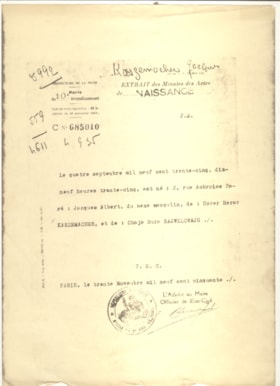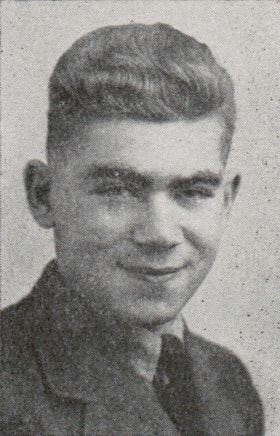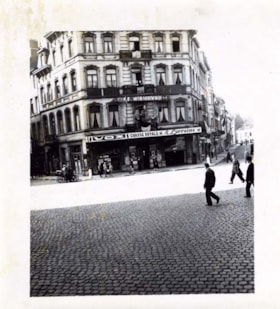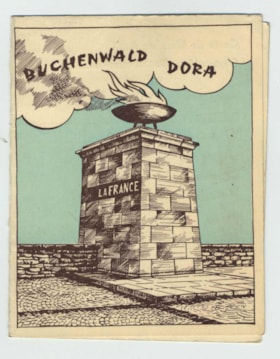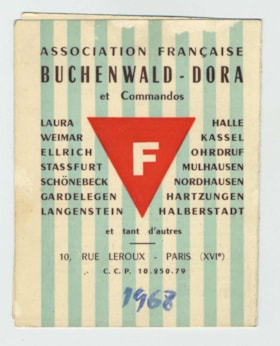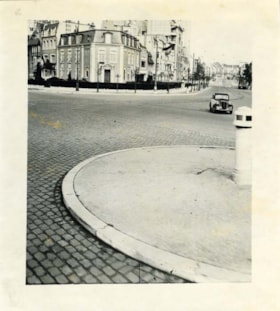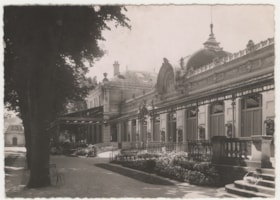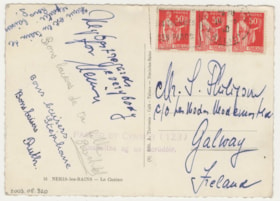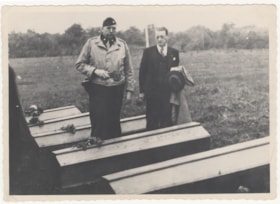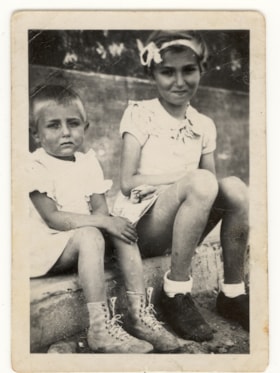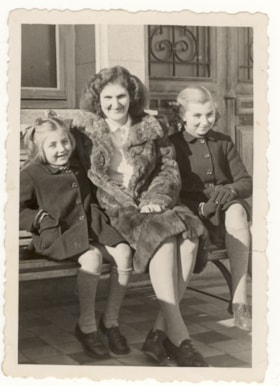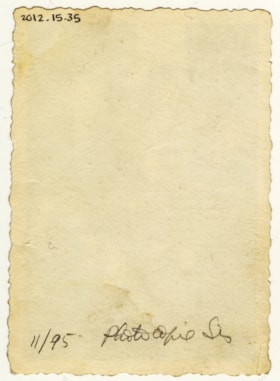Narrow Results By
Place
- Aix-les-Bains, France, Europe 1
- Alixan, France, Europe 1
- Andresy, France, Europe 12
- Andrésy, France, Europe 1
- Andrésy, France, Europe 3
- Bagnères-de-Luchon, France, Europe 1
- Bagnères, France, Europe 1
- Bayeux Memorial 2
- Bayeux War Cemetery 1
- Beny-sur-Mer Canadian War Cemetery, Reviers 14
- Bermering (Bermerange) Communal Cemetery 1
- Bernac-Dessus, France, Europe 2
BERNARD, Lionel (Levy)
https://www.cjhn.ca/link/genealogy43
- Collection
- Canadian Jewish Congress organizational records
- Material Type
- textual record
- graphic material
- Archival / Genealogical
- Genealogy Records
- Material Type
- textual record
- graphic material
- Date of Birth
- December 26, 1891
- Date of Death
- October 09, 1916
- Place of Burial
- Pas de Calais, France
- Cemetery
- Vimy Memorial
- Age at Time of Death
- 24
- Enlistment No.
- 27043
- Rank
- Staff Sergeant
- Unit
- 15th Canadian Infantry (Central Ontario Regiment)
- Notes
- Staff Sergeant Lionel Bernard was from London, England.
- Subjects
- World War I
- Record Source
- Canadian Jewish Military Casualties
- Fonds No.
- CJC0001
- Archival / Genealogical
- Genealogy Records
- Repository
- Canadian Jewish Archives
Images
Birth certificate
https://www.cjhn.ca/link/cjhn78444
- Collection
- Montreal Holocaust Museum
- Description Level
- Item
- Material Type
- textual record
- Physical Description
- Birth certificate : Paper : Ink : beige, black ; Ht: 29,4 cm x W: 20,8 cm
- Date
- November 30, 1950
- Collection
- Montreal Holocaust Museum
- Description Level
- Item
- Material Type
- textual record
- Physical Description
- Birth certificate : Paper : Ink : beige, black ; Ht: 29,4 cm x W: 20,8 cm
- Other Title Information
- Documentary Artifact
- Date
- November 30, 1950
- Physical Condition
- Excellent
- Language
- French
- Notes
- One page. One-sided photocopy of an official document. On the t. is the name Kaszemacher, Jacques. The document give the details of his birth. Narrative: Jacques Kasma was born Jacques Kaszemacher on 1935-09-04 in the 10th arrondissement of Paris (France). His father was Uszer Hersz Kaszemacher, also known as Henric Kasmacher, born on 1913-04-05 in Parczew (Poland). His mother was Chaja Sura Bajwelcwajg, born 1915-05-19 in Warsaw (Poland). Jacques had a younger sister, Jeannine, born in 1937. In 1940, Henri Kasmacher was a driver in the French army. He was captured by the German armed forces in Saint-Die-des-Vosges (France) and was deported to the forced labour camp of Brunswiek, a subcamp of Neuengamme concentration camp ( Germany). In 1943, Chaja Bajwelcwajg was arrested and interned at the Drancy transit camp (France). She died in Drancy on 1943-09-02. Jacques was hidden in Normandy (France) during the war. After Liberation, he spent time in an orphanage ran by the OSE in Le Vésinet. He met Marcel Marceau, a famous French mime, who taught him his art. Henri Kasmacher survived the war and came back to France and remarried to Ida Wolnowicz. In 1956, Jacques Kasma settled in Montreal (Canada) where he pursued an artistic career. He acted as a mime named Tit-Bo on the children's television program "La Boîte à Surprise". He worked at the National Film Board as an editor and director. He also worked with the filmmaker Gilles Groulx. He went back to France to fulfill his military service obligations and moved back to Montreal in 1960. He was part of the Douglas hospital psychiatric research team for 20 years.
- Accession No.
- 2014.24.15
- Name Access
- Kasma, Puck
- Places
- Paris, France, Europe
- Archival / Genealogical
- Archival Descriptions
- Repository
- Montreal Holocaust Museum
Images
BLATT (BLATTIN), Louis
https://www.cjhn.ca/link/genealogy50
- Collection
- Canadian Jewish Congress organizational records
- Material Type
- textual record
- graphic material
- Archival / Genealogical
- Genealogy Records
- Material Type
- textual record
- graphic material
- Date of Death
- August 08, 1944
- Place of Burial
- Calvados, France
- Enlistment No.
- H-36824
- Rank
- Private
- Unit
- North Shore (New Brunswick) Regiment, R.C.I.C.
- Notes
- Private Louis Blatt of Winnipeg, Manitoba, was officially reported killed in action in France on August 8, 1944.
- Subjects
- World War II
- Record Source
- Canadian Jewish Military Casualties
- Fonds No.
- CJC0001
- Archival / Genealogical
- Genealogy Records
- Repository
- Canadian Jewish Archives
Images
Bombed out buildings in rural area, World War II, France.
https://www.cjhn.ca/link/cjhn80289
- Collection
- Allan Raymond Collection
- Description Level
- Item
- Material Type
- graphic material
- Physical Description
- 1 photograph : b&w ; 12.6 x 11.1 cm
- Fonds No.
- 1034; 3; 024027
- Date
- 1944
- Collection
- Allan Raymond Collection
- Description Level
- Item
- Material Type
- graphic material
- Physical Description
- 1 photograph : b&w ; 12.6 x 11.1 cm
- Date
- 1944
- Fonds No.
- 1034
- Series No.
- 3
- Item No.
- 024027
- Storage Location
- 9-5E
- Creator
- Crown
- Subjects
- World War, 1939-1945
- Places
- France
- Archival / Genealogical
- Archival Descriptions
- Repository
- Jewish Public Library Archives
Images
Bottle
https://www.cjhn.ca/link/cjhn45709
- Collection
- Montreal Holocaust Museum
- Description Level
- Item
- Material Type
- object
- Physical Description
- Bottle : painted : multi-coloured ; Ht: 21,7 cm x W: 7,5 cm
- Date
- 1941-1944
- Collection
- Montreal Holocaust Museum
- Description Level
- Item
- Material Type
- object
- Physical Description
- Bottle : painted : multi-coloured ; Ht: 21,7 cm x W: 7,5 cm
- Other Title Information
- Decorative Art
- Date
- 1941-1944
- Physical Condition
- Good
- Language
- French
- Notes
- Glass bottle with a wooden stopper. Inside the bottle is a crucifixion scene showing figure of a man (Jesus) hanging from a crucifix. The man has painted yellow skin with bits of black hair and beard. The crucifix is painted in orange and silver. There are also four tall tower-like structures painted orange, yellow, blue, and silver; two on the right of the crucifix and two on the left. A silver ladder is positioned under the crucified man. The whole is set into a silver base in two pieces. Narrative: The bottle was handcrafted by a Ukrainian prisoner of war in the Ban Saint-Jean camp. Many of the Soviet prisoners formed close ties with the local farmers, on whose farmers they were sent to work. They created handicrafts such as bottles, baskets, and wooden toys to give as gifts or to trade for food. This bottle was given to Anna Kremer, who lived in Boulay (village close to the camp) by a prisoner to whom she had given food and shoes. Many examples of such bottles and other handmade gifts were given to villagers in appreciation for their help to the prisoners of war. An estimated 22,000 Soviet prisoners of war died at Ban Saint-Jean of malnutrition and exhaustion between 1941-1944.
- Accession No.
- 2011.374.01
- Name Access
- Silès, Damien
- Archival / Genealogical
- Archival Descriptions
- Repository
- Montreal Holocaust Museum
Images
Boys at the OSE home in Le Vesinet
https://www.cjhn.ca/link/cjhn78442
- Collection
- Montreal Holocaust Museum
- Description Level
- Item
- Material Type
- graphic material
- Physical Description
- Photograph : Paper : printed : Ink : B&W ; Ht: 6,7 cm x W: 9,6 cm
- Date
- 1948
- Collection
- Montreal Holocaust Museum
- Description Level
- Item
- Material Type
- graphic material
- Physical Description
- Photograph : Paper : printed : Ink : B&W ; Ht: 6,7 cm x W: 9,6 cm
- Other Title Information
- Documentary Artifact
- Date
- 1948
- Physical Condition
- Excellent
- Language
- French
- Notes
- B&W photograph with border. Outdoors. Group of boys posing in a yard. On the rignt is a young woman problably in charge of the group. Narrative: Jacques Kasma was born Jacques Kaszemacher on 1935-09-04 in the 10th arrondissement of Paris (France). His father was Uszer Hersz Kaszemacher, also known as Henric Kasmacher, born on 1913-04-05 in Parczew (Poland). His mother was Chaja Sura Bajwelcwajg, born 1915-05-19 in Warsaw (Poland). Jacques had a younger sister, Jeannine, born in 1937. In 1940, Henri Kasmacher was a driver in the French army. He was captured by the German armed forces in Saint-Die-des-Vosges (France) and was deported to the forced labour camp of Brunswiek, a subcamp of Neuengamme concentration camp ( Germany). In 1943, Chaja Bajwelcwajg was arrested and interned at the Drancy transit camp (France). She died in Drancy on 1943-09-02. Jacques was hidden in Normandy (France) during the war. After Liberation, he spent time in an orphanage ran by the OSE in Le Vésinet. He met Marcel Marceau, a famous French mime, who taught him his art. Henri Kasmacher survived the war and came back to France and remarried to Ida Wolnowicz. In 1956, Jacques Kasma settled in Montreal (Canada) where he pursued an artistic career. He acted as a mime named Tit-Bo on the children's television program "La Boîte à Surprise". He worked at the National Film Board as an editor and director. He also worked with the filmmaker Gilles Groulx. He went back to France to fulfill his military service obligations and moved back to Montreal in 1960. He was part of the Douglas hospital psychiatric research team for 20 years.
- Accession No.
- 2014.24.10
- Name Access
- Kasma, Puck
- Places
- Le Vesinet, France, Europe
- Archival / Genealogical
- Archival Descriptions
- Repository
- Montreal Holocaust Museum
Images
Brick street leading to demolished buildings, World War II, France.
https://www.cjhn.ca/link/cjhn80280
- Collection
- Allan Raymond Collection
- Description Level
- Item
- Material Type
- graphic material
- Physical Description
- 1 photograph : b&w ; 13.3 x 12.2 cm
- Fonds No.
- 1034; 3; 024017
- Date
- 1944
- Collection
- Allan Raymond Collection
- Description Level
- Item
- Material Type
- graphic material
- Physical Description
- 1 photograph : b&w ; 13.3 x 12.2 cm
- Date
- 1944
- Fonds No.
- 1034
- Series No.
- 3
- Item No.
- 024017
- Storage Location
- 9-5E
- Creator
- Crown
- Subjects
- World War, 1939-1945
- Places
- France
- Archival / Genealogical
- Archival Descriptions
- Repository
- Jewish Public Library Archives
Images
Brinberg, Georgette - Oral History of a Holocaust Survivor
https://www.cjhn.ca/link/cjhn60315
- Collection
- WITNESS TO HISTORY COLLECTION (MHMC-02)
- Description Level
- Item
- Material Type
- moving images
- Physical Description
- 01:32:00
- Collection
- WITNESS TO HISTORY COLLECTION (MHMC-02)
- Description Level
- Item
- Material Type
- moving images
- Physical Description
- 01:32:00
- Language
- English; French
- Notes
- Georgette Brinberg (née Tepicht) was born on June 10, 1938 in the mining town of Villerupt in northern France. In the 1940s, when the town was attacked by Germany, her mother, father and older sister fled to Paris. Although she was young, she remembers that her father in 1940 was rounded-up and sent to a working camp, and eventually to Auschwitz. In July 1942, she, her sister and mother were rounded up and sent off to the Vélodrome d’Hiver where she stayed for a week until she was split up from her mother and destined to be sent to Auschwitz. Fortunately, Georgette and her sister were able to flee the Vel d’Hiv and were sent to Morée. She does not remember how she ended up there, but she does know that she was in hiding with her sister, and that there was a constant fear of being captured. She had to learn all the Catholic rites in order to pass off as a Catholic girl. In 1944, about the time of the liberation of France, she once more fled Morée and returned to Paris after jumping onto an American truck. Once she arrived in Paris with her sister, they sought out their grandmother who was still in hiding. All three stayed in hiding until the end of the war, and eventually moved to Israel in 1948. In Israel, she joined the Kibbutz – a collective community traditionally based on agriculture. She stayed there, learning Yiddish, until the 1950s. She eventually decided to move to Canada where her sister lived with her husband. In 1955, she finally arrived in Montreal where she went to business school and worked in the Quebec Order of Chartered Accountants. She married in 1957 and had three kids. In subsequent years, she researched the whereabouts of her family and tried to find a trace of those that helped her. She even returned to Paris to learn more about her past and her family legacy. She feels that her story should be told for future generations to remember, in her words: “if I can tell my grandchildren, then why not everyone [else]?”
- Accession No.
- WTH-462
- Name Access
- Brinberg, Georgette
- Places
- Villerupt, France, Europe
- Archival / Genealogical
- Archival Descriptions
- Repository
- Montreal Holocaust Museum
Images
BROWNSTONE, Yude
https://www.cjhn.ca/link/genealogy64
- Collection
- Canadian Jewish Congress organizational records
- Material Type
- textual record
- graphic material
- Archival / Genealogical
- Genealogy Records
- Material Type
- textual record
- graphic material
- Date of Birth
- February 19, 1924
- Date of Death
- July 04, 1944
- Place of Burial
- Calvados, France
- Age at Time of Death
- 20
- Enlistment No.
- H-10710
- Rank
- Rifleman
- Unit
- Royal Winnipeg Rifles
- Notes
- Rifleman Yude Brownstone of Winnipeg, Manitoba, was officially reported killed in action on July 4, 1944. Rifleman Brownstone enlisted in the army in June 1943 and arrived overseas in March 1944. He was killed at Carpiquet, France.
- Subjects
- World War II
- Record Source
- Canadian Jewish Military Casualties
- Fonds No.
- CJC0001
- Archival / Genealogical
- Genealogy Records
- Repository
- Canadian Jewish Archives
Images
Building with Vox/Chasse Royale/La Lorraine sign on corner of cobblestone street, World War II, France.
https://www.cjhn.ca/link/cjhn80285
- Collection
- Allan Raymond Collection
- Description Level
- Item
- Material Type
- graphic material
- Physical Description
- 1 photograph : b&w ; 10.9 x 12.1 cm
- Fonds No.
- 1034; 3; 024023
- Date
- 1944
- Collection
- Allan Raymond Collection
- Description Level
- Item
- Material Type
- graphic material
- Physical Description
- 1 photograph : b&w ; 10.9 x 12.1 cm
- Date
- 1944
- Fonds No.
- 1034
- Series No.
- 3
- Item No.
- 024023
- Storage Location
- 9-5E
- Subjects
- World War, 1939-1945
- Places
- France
- Archival / Genealogical
- Archival Descriptions
- Repository
- Jewish Public Library Archives
Images
Card
https://www.cjhn.ca/link/cjhn50345
- Collection
- Montreal Holocaust Museum
- Description Level
- Item
- Material Type
- textual record
- Physical Description
- Card : Paper : Ink : Black, White, Blue, Red ; Ht: 4 in. x W: 3,25 in.
- Date
- 1954-04-11-1968
- Collection
- Montreal Holocaust Museum
- Description Level
- Item
- Material Type
- textual record
- Physical Description
- Card : Paper : Ink : Black, White, Blue, Red ; Ht: 4 in. x W: 3,25 in.
- Other Title Information
- Documentary Artifact
- Date
- 1954-04-11-1968
- Physical Condition
- Good
- Language
- French
- German
- Notes
- 2 pages, front cover has an illustration of a brick chimney with a basin on the top, with a fire coming out of it, and a cloud above it. Back cover has blue and white stripes and a red triangle with the letter F in the centre (identification of French political prisoners). Membership card for the French Association of survivors of Buchenwald Dora and camps. Narrative: Donor Desire Klein was a survivor of Buchenwald concentration camp.
- Accession No.
- 1998.46.01
- Name Access
- Klein, Desiré
- Places
- Paris, France, Europe
- Archival / Genealogical
- Archival Descriptions
- Repository
- Montreal Holocaust Museum
Images
Car driving on cobblestone city street, France, World War II.
https://www.cjhn.ca/link/cjhn80268
- Collection
- Allan Raymond Collection
- Description Level
- Item
- Material Type
- graphic material
- Physical Description
- 1 photograph : b&w ; 12.4 x 11 cm
- Fonds No.
- 1034; 3; 024005
- Date
- 1944
- Collection
- Allan Raymond Collection
- Description Level
- Item
- Material Type
- graphic material
- Physical Description
- 1 photograph : b&w ; 12.4 x 11 cm
- Date
- 1944
- Fonds No.
- 1034
- Series No.
- 3
- Item No.
- 024005
- Storage Location
- 9-5E
- Subjects
- World War, 1939-1945
- Automobiles
- Places
- France
- Archival / Genealogical
- Archival Descriptions
- Repository
- Jewish Public Library Archives
Images
Casino in Neris-les-Bains
https://www.cjhn.ca/link/cjhn49758
- Collection
- Montreal Holocaust Museum
- Description Level
- Item
- Material Type
- textual record
- Physical Description
- Postcard : Paper : Beige, White, Black ; Ht: 10,4 cm x W: 14,7 cm
- Date
- [Later than 1940]
- Collection
- Montreal Holocaust Museum
- Description Level
- Item
- Material Type
- textual record
- Physical Description
- Postcard : Paper : Beige, White, Black ; Ht: 10,4 cm x W: 14,7 cm
- Other Title Information
- Documentary Artifact
- Date
- [Later than 1940]
- Language
- French
- Notes
- Recto has b&w photograph of the casino building in Neris-les-bains. On verso are handwritten messages and address with three red postal stamps on top right with ink stamps. Postcard sent to Serge Philipson in Galway by his daughter Rachel and her cousins Ruth and Stephane. Narrative: In the 1930’s Rachel Levy’s parents, Serge and Sophie Philipson moved from Berlin to Paris due to antisemitism. After a few years, Serge started working in his brother-in-law’s, Henri, company “Les Modes Modernes”. An opportunity to expand the business in Ireland resulted in Serge moving to Irland while his wife Sophie and daughter Rachel stayed in France. In July 1938, the factory opened in Ireland, Rachel and Sophie went for the opening and came back to Paris. In August 1939, Sophie, Rachel, and other family members (Stéphane, Esther, Choura and her mother) went to Cabourg, in Normandy, while Augusta, Ella and Ruth went to Neris-les-bains. Since Paris wasn’t safe for Jews anymore, they decided to stay in Cabourg and rented a small house; Rachel was nine years old and started school there. After winter 1939-1940 it was difficult to communicate with Ireland but the family could still send and receive letters from Serge. At the end of winter 1940 Rachel moved to Neris-les-Bains where the rest of the family was. In July 1940, they left for Cauterets where Robert, Serge’s brother, was staying. They rented an apartment owned by Madame Noebès on rue Richelieu (close to the Spanish border). In 1940, Henri and Stéphane returned to the Riviera. With Néné, they moved to Hotel Victoria on the rue Antibes in Cannes. In August 1942, Mr. Kleinman (a friend from Paris) arrived in Cauterets and told them that Jews who had come to France after 1933 would be deported. Ella, Ernest, Ruth, Robert and Esther were arrested by local police and would be deported and killed later on. At the beginning of 1943, Sophie, her daughter Rachel, Oma, Henri, Stéphane and Néné left Cauterets to move to Maubourguet. In April 1943, they moved to Cannes in Hotel Victoria. On July 15 1943, Rachel turned 15 years old. Mr. Borello offered to hide Henri, Sophie and Grandmother Augusta (Oma) while Stéphane and Rachel were taken care of by Néné and returned to Maubourguet. In January 1944, Henri, Sophie and Augusta were denounced, arrested and transferred to Marseille and then sent by train to Drancy from where they were later deported (they did not survive). Jean (who was in a relationship with Rachel’s aunt Suzanne) came to Maubourget, gave Rachel his daughter’s identity “Jacqueline” and she left for Juan-les-Pins. In 1944, she moved from one place to another and still continued to correspond with her father. At the end of the war, Rachel met her uncle Shaja at the Polish Consulate in Lyon. He offered to help her to get papers to go to Ireland. On June 14, 1945, she spent three days in London with some family members and then took a boat-train for Dublin where she was reunited with her father, Serge, whom she had not seen for 6 years. In 1951, Rachel got married. She had four sons and has been living in Montreal since 1954.
- Accession No.
- 2002.08.320
- Name Access
- Levy, Rachel
- Archival / Genealogical
- Archival Descriptions
- Repository
- Montreal Holocaust Museum
Images
Caskets of victims of the tragedy of Guerry’s wells
https://www.cjhn.ca/link/cjhn50022
- Collection
- Montreal Holocaust Museum
- Description Level
- Item
- Material Type
- graphic material
- Physical Description
- Photograph : paper : b&w ; Ht: 12,5 cm x W: 17,4 cm
- Date
- 1944
- Collection
- Montreal Holocaust Museum
- Description Level
- Item
- Material Type
- graphic material
- Physical Description
- Photograph : paper : b&w ; Ht: 12,5 cm x W: 17,4 cm
- Other Title Information
- Documentary Artifact
- Date
- 1944
- Physical Condition
- Good
- Notes
- White border with deckled edges. Outdoor scene of two men surrounded by casket laying on the ground in a field with a forest in the background. The man on the left seems like military. Some flowers have been laid on the caskets. The caskets belong to victims of the tragedy of Guerry’s wells. Narrative: The tragedy of Guerry’s wells is a jewish persecution that took place the night of the 21st and 22nd of July 1944 at Saint-Amand-Montrond (France) on a farm. 36 persons where thrown in three different wells along with some stones in order to crush them alive. Since the beginning of the war many Jewish hid there. Charles Krameisen was the only survivor. He went to the police to tell the tragedy. Robert Monheit (the donor) helped to hid Jews from Alsace-Lorraine (his hometown) to Saint-Amand-Montrond and nearby villages such as La Chartre. He gave lessons to the son of Charles Krameisen to prepare for his bar mitzvah. Regarding the wells, as he was in charge of reorganizing the post-war Jewish life in Alsace-Lorraine and had already links with Saint-Amand, he was part of the witnesses invited to attend the exhumation of the bodies of victims. His religious functions confirmed that the survivors had lost their spouses and therefore gave them permission to remarry.
- Accession No.
- 2012.31.44
- Name Access
- Monheit, Robert
- Places
- St-Amand, France, Europe
- Archival / Genealogical
- Archival Descriptions
- Repository
- Montreal Holocaust Museum
Images
Celinka (Cecile) and Elzbieta (Elizabeth) Zilberbogen
https://www.cjhn.ca/link/cjhn48238
- Collection
- Montreal Holocaust Museum
- Description Level
- Item
- Material Type
- graphic material
- Physical Description
- Photograph : paper : b&w ; Ht: 8,6 cm x W: 6,1 cm
- Date
- [ca. 1942]
- Collection
- Montreal Holocaust Museum
- Description Level
- Item
- Material Type
- graphic material
- Physical Description
- Photograph : paper : b&w ; Ht: 8,6 cm x W: 6,1 cm
- Other Title Information
- Documentary Artifact
- Date
- [ca. 1942]
- Physical Condition
- Good
- Notes
- White border. Outdoor portrait in which Celinka (Cecile) is sitting on the left and Elzbieta (Elizabeth) Zilberogen is sitting on the right. They are sitting on the sidewalk both of them wearing a light dress. Elzbieta (Elizabeth) has a ribbon in her hair. Narrative: The Zilberbogen were a Jewish family originally from Warsaw (Poland). Mother Chana and daughters Elzbieta (born 1933) and Celinka (born 1937) moved to Belgium in 1939. The father, Szygmundt, an engineer, stayed in Poland. During the Second World War, the mother and daughters were first sent to a transit camp in the South of France before being released. Chana was then hospitalized and spent the war hidden in a Sanatorium in Mazamet. Elzbieta and Celinka were hidden in various locations in the South of France, including a farm and different children's homes run by OSE. Szygmundt was killed in Poland. Chana and her daughters went back to live in Belgium after Liberation until immigrating to Canada in 1951.
- Accession No.
- 2012.15.26
- Name Access
- Peltier, Cécile
- Places
- France, Europe
- Archival / Genealogical
- Archival Descriptions
- Repository
- Montreal Holocaust Museum
Images
Celinka (Cecile), Elzbieta (Elizabeth) and Chana Zilberbogen
https://www.cjhn.ca/link/cjhn48252
- Collection
- Montreal Holocaust Museum
- Description Level
- Item
- Material Type
- graphic material
- Physical Description
- Photograph : paper : b&w ; Ht: 8,5 cm x W: 6 cm
- Date
- [ca. 1942]
- Collection
- Montreal Holocaust Museum
- Description Level
- Item
- Material Type
- graphic material
- Physical Description
- Photograph : paper : b&w ; Ht: 8,5 cm x W: 6 cm
- Other Title Information
- Documentary Artifact
- Date
- [ca. 1942]
- Physical Condition
- Good
- Notes
- White border, outdoor scene. From left to right, Celinka (Cecile), Chana and Elzbieta (Elizabeth) Zilberbogen standing up in winter clothes. Chana is wearing a fur coat and the two girls a wool coat. The three of them a wearing tights. Narrative: The Zilberbogen were a Jewish family originally from Warsaw (Poland). Mother Chana and daughters Elzbieta (born 1933) and Celinka (born 1937) moved to Belgium in 1939. The father, Szygmundt, an engineer, stayed in Poland. During the Second World War, the mother and daughters were first sent to a transit camp in the South of France before being released. Chana was then hospitalized and spent the war hidden in a Sanatorium in Mazamet. Elzbieta and Celinka were hidden in various locations in the South of France, including a farm and different children's homes run by OSE. Szygmundt was killed in Poland. Chana and her daughters went back to live in Belgium after Liberation until immigrating to Canada in 1951.
- Accession No.
- 2012.15.36
- Name Access
- Peltier, Cécile
- Places
- France, Europe
- Archival / Genealogical
- Archival Descriptions
- Repository
- Montreal Holocaust Museum
Images
Celinka (Cecile), Elzbieta (Elizabeth) and Chana Zilberbogen
https://www.cjhn.ca/link/cjhn48267
- Collection
- Montreal Holocaust Museum
- Description Level
- Item
- Material Type
- graphic material
- Physical Description
- Photograph : paper : b&w ; Ht: 8,7 cm x W: 6,1 cm
- Date
- [ca. 1942]
- Collection
- Montreal Holocaust Museum
- Description Level
- Item
- Material Type
- graphic material
- Physical Description
- Photograph : paper : b&w ; Ht: 8,7 cm x W: 6,1 cm
- Other Title Information
- Documentary Artifact
- Date
- [ca. 1942]
- Physical Condition
- Good
- Language
- French
- Notes
- White border with deckled edges. Outdoor scene. From left to right, Celinka (Cecile), Chana and Elzbieta (Elizabeth) Zilberbogen sitting on a bench with winter clothes. Chana is wearing a fur coat and the two girls a wool coat. The three of them a wearing tights. Narrative: The Zilberbogen were a Jewish family originally from Warsaw (Poland). Mother Chana and daughters Elzbieta (born 1933) and Celinka (born 1937) moved to Belgium in 1939. The father, Szygmundt, an engineer, stayed in Poland. During the Second World War, the mother and daughters were first sent to a transit camp in the South of France before being released. Chana was then hospitalized and spent the war hidden in a Sanatorium in Mazamet. Elzbieta and Celinka were hidden in various locations in the South of France, including a farm and different children's homes run by OSE. Szygmundt was killed in Poland. Chana and her daughters went back to live in Belgium after Liberation until immigrating to Canada in 1951.
- Accession No.
- 2012.15.35
- Name Access
- Peltier, Cécile
- Places
- France, Europe
- Archival / Genealogical
- Archival Descriptions
- Repository
- Montreal Holocaust Museum
Images
Celinka (Cecile), Elzbieta (Elizabeth) Zilberbogen and other children from OSE children home
https://www.cjhn.ca/link/cjhn48216
- Collection
- Montreal Holocaust Museum
- Description Level
- Item
- Material Type
- graphic material
- Physical Description
- Photograph : paper : b&w ; Ht: 8,5 cm x W: 12,5 cm
- Date
- 1942
- Collection
- Montreal Holocaust Museum
- Description Level
- Item
- Material Type
- graphic material
- Physical Description
- Photograph : paper : b&w ; Ht: 8,5 cm x W: 12,5 cm
- Other Title Information
- Documentary Artifact
- Date
- 1942
- Physical Condition
- Excellent
- Language
- French
- Notes
- No border, outdoor scene. 26 boys and girls (one adult) standing and sitting in front of a building on the sand. In the middle, standing up there is Elzbieta (Elizabeth) Zilberbogen. The first one sitting from the left is Celinka (Cecile) Zilberbogen. Narrative: The Zilberbogen were a Jewish family originally from Warsaw (Poland). Mother Chana and daughters Elzbieta (born 1933) and Celinka (born 1937) moved to Belgium in 1939. The father, Szygmundt, an engineer, stayed in Poland. During the Second World War, the mother and daughters were first sent to a transit camp in the South of France before being released. Chana was then hospitalized and spent the war hidden in a Sanatorium in Mazamet. Elzbieta and Celinka were hidden in various locations in the South of France, including a farm and different children's homes run by OSE. Szygmundt was killed in Poland. Chana and her daughters went back to live in Belgium after Liberation until immigrating to Canada in 1951.The “Œuvre de secours aux enfants” (OSE) is a Jewish organization designed to help children. OSE was established in 1912 in St. Petersburg (Russia) by doctors to help disadvantaged Jewish populations. It was then called the “Society for the health protection of the Jewish population”, in Russian Obshchetsvo Zdravookhraneniya Yevreyiev, abbreviated OZE. It rescued thousands of Jewish children during the Second World War.
- Accession No.
- 2012.15.28
- Name Access
- Peltier, Cécile
- Places
- Palavas, France, Europe
- Archival / Genealogical
- Archival Descriptions
- Repository
- Montreal Holocaust Museum
Images
Celinka (Cecile) Zilberbogen
https://www.cjhn.ca/link/cjhn48284
- Collection
- Montreal Holocaust Museum
- Description Level
- Item
- Material Type
- graphic material
- Physical Description
- Photograph : paper : b&w ; Ht: 11,1 cm x W: 17,1 cm
- Date
- [Later than 1945]
- Collection
- Montreal Holocaust Museum
- Description Level
- Item
- Material Type
- graphic material
- Physical Description
- Photograph : paper : b&w ; Ht: 11,1 cm x W: 17,1 cm
- Other Title Information
- Documentary Artifact
- Date
- [Later than 1945]
- Physical Condition
- Good
- Language
- French
- Notes
- White border, indoor scene. Celinka (Cecile) Zilberbogen talking to another girl besides her. In the background, a window and an ornementation representing horses. Narrative: The Zilberbogen were a Jewish family originally from Warsaw (Poland). Mother Chana and daughters Elzbieta (born 1933) and Celinka (born 1937) moved to Belgium in 1939. The father, Szygmundt, an engineer, stayed in Poland. During the Second World War, the mother and daughters were first sent to a transit camp in the South of France before being released. Chana was then hospitalized and spent the war hidden in a Sanatorium in Mazamet. Elzbieta and Celinka were hidden in various locations in the South of France, including a farm and different children's homes run by OSE. Szygmundt was killed in Poland. Chana and her daughters went back to live in Belgium after Liberation until immigrating to Canada in 1951.
- Accession No.
- 2012.15.43
- Name Access
- Peltier, Cécile
- Places
- Andresy, France, Europe
- Archival / Genealogical
- Archival Descriptions
- Repository
- Montreal Holocaust Museum
Images
Celinka (Cecile) Zilberbogen in Andresy
https://www.cjhn.ca/link/cjhn48245
- Collection
- Montreal Holocaust Museum
- Description Level
- Item
- Material Type
- graphic material
- Physical Description
- Photograph : paper : b&w ; Ht: 12,6 cm x W: 17,9 cm
- Date
- [Later than 1945]
- Collection
- Montreal Holocaust Museum
- Description Level
- Item
- Material Type
- graphic material
- Physical Description
- Photograph : paper : b&w ; Ht: 12,6 cm x W: 17,9 cm
- Other Title Information
- Documentary Artifact
- Date
- [Later than 1945]
- Physical Condition
- Good
- Language
- French
- Notes
- White border, outdoor scene. Group portrait walking in front of a building with Celinka (Cecile) Zilberbogen standing on the left in the second front row. Narrative: The Zilberbogen were a Jewish family originally from Warsaw (Poland). Mother Chana and daughters Elzbieta (born 1933) and Celinka (born 1937) moved to Belgium in 1939. The father, Szygmundt, an engineer, stayed in Poland. During the Second World War, the mother and daughters were first sent to a transit camp in the South of France before being released. Chana was then hospitalized and spent the war hidden in a Sanatorium in Mazamet. Elzbieta and Celinka were hidden in various locations in the South of France, including a farm and different children's homes run by OSE. Szygmundt was killed in Poland. Chana and her daughters went back to live in Belgium after Liberation until immigrating to Canada in 1951.
- Accession No.
- 2012.15.41
- Name Access
- Peltier, Cécile
- Places
- Andresy, France, Europe
- Archival / Genealogical
- Archival Descriptions
- Repository
- Montreal Holocaust Museum
Images
{{ server.message }}


